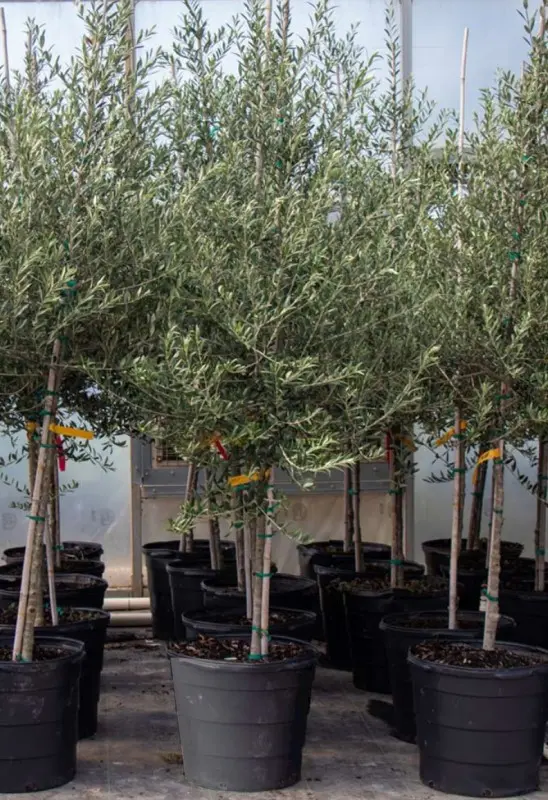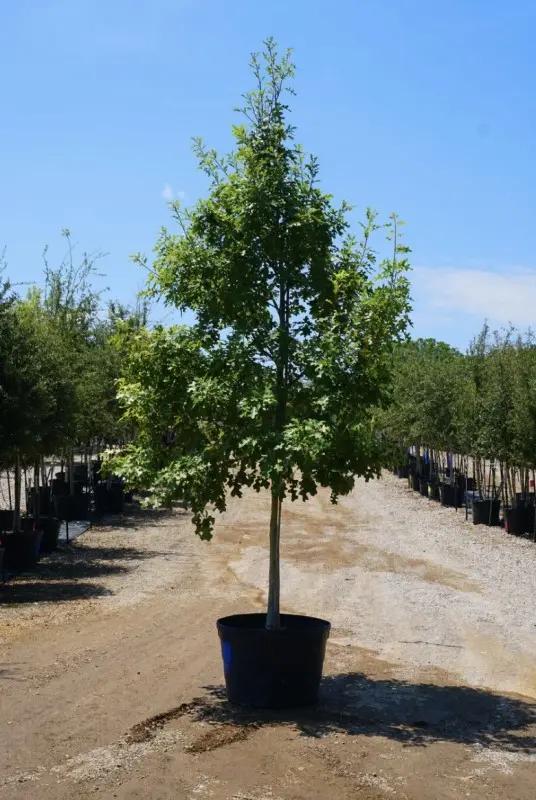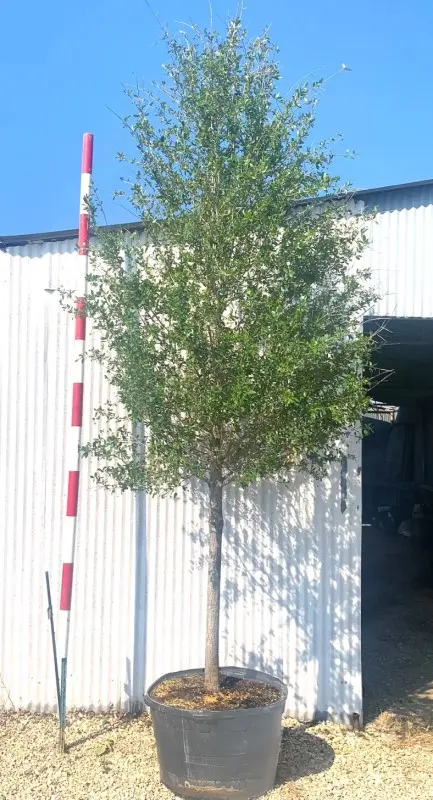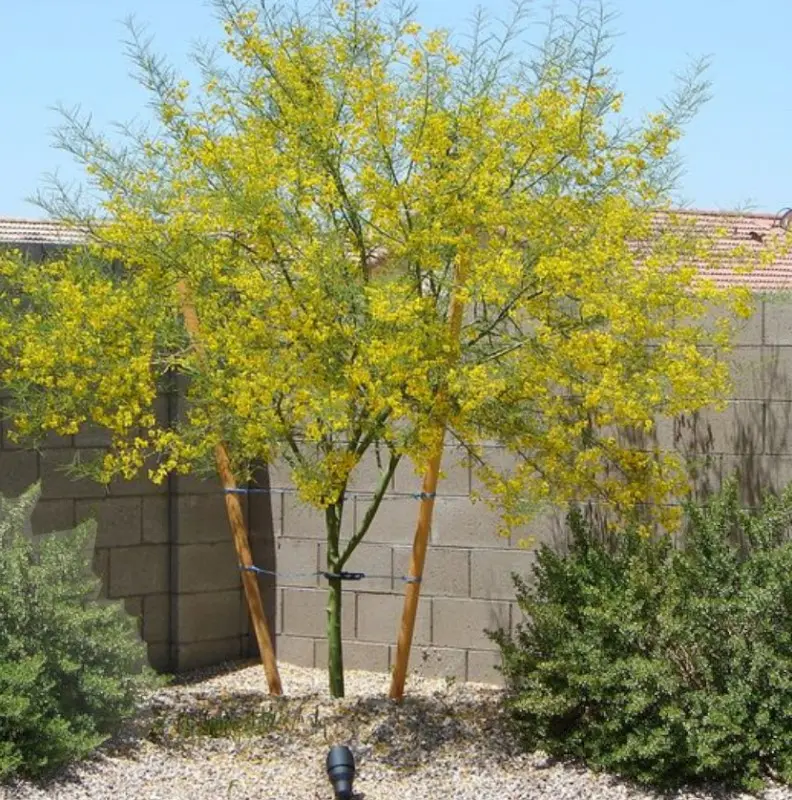-

Bur Oak
$0.00
Evergreen
Grow up to 12" per year
Up to 70' tall
-
Bur Oak (Quercus macrocarpa), also known as Mossy Cup Oak, is a large, deciduous oak tree known for its thick, deeply furrowed bark, massive acorns, and impressive resilience. Native to North America, the Bur Oak can reach heights of 70 to 80 feet with a similar or slightly smaller spread, making it a grand, stately tree ideal for open landscapes. Its large, lobed leaves turn a golden yellow in the fall, adding seasonal interest, and its unique acorns—some of the largest of any oak—feature a fringed, “mossy” cap that provides an important food source for wildlife.
Bur Oaks thrive in USDA zones 3-8 and are well-suited to full sun and a variety of soil types, including clay, sandy, and loamy soils. They are especially tolerant of drought, pollution, and even poor soil, making them highly adaptable for urban environments and large open spaces. This tree’s deep, extensive root system enables it to withstand extreme conditions and contributes to its exceptional longevity, with many Bur Oaks living several hundred years.
Low-maintenance and pest-resistant, Bur Oaks require little care beyond occasional pruning in late winter to remove dead or damaged branches. Their robust structure and hardiness make them popular as shade trees in parks, golf courses, and expansive properties, where their large canopy provides cooling shade and creates a picturesque landscape. With its rugged bark, distinctive acorns, and adaptability, Bur Oak offers both ecological and aesthetic value, standing as a resilient, enduring presence in any landscape.
-

Olive Tree
$0.00
Evergreen
Slow growth rate
Up to 25'
-
Olive Tree (Olea europaea) is an evergreen tree native to the Mediterranean region, renowned for its silvery-green foliage, gnarled trunk, and edible fruit. Cultivated for thousands of years, Olive trees are highly valued for their olives and olive oil, as well as their ornamental beauty in landscapes. The tree’s narrow, elongated leaves are dark green on top and silvery-gray underneath, creating a distinctive, shimmering appearance. Olive trees bloom in late spring, producing small, fragrant, creamy-white flowers that give way to green fruits, which ripen to a purplish-black or dark green in late summer or early fall.
Typically growing 20 to 30 feet tall and wide, Olive trees have a slow to moderate growth rate and can live for centuries, with many specimens displaying their signature twisting, gnarled trunks as they age. They thrive in USDA zones 8-11, preferring full sun and well-draining soil with a slightly alkaline pH. Olive trees are drought-tolerant once established and can withstand hot, dry climates as well as coastal conditions, making them ideal for Mediterranean and arid landscapes. While they are frost-sensitive, certain cold-hardy varieties can withstand brief dips in temperature, allowing them to grow in slightly cooler regions.
Low-maintenance and relatively pest-resistant, Olive trees require minimal pruning, typically in late winter to early spring, to shape or control size. They are often used as specimen trees, in groves, or in pots, bringing a classic, Mediterranean aesthetic to gardens, courtyards, and patios. With their elegant foliage, historical significance, and adaptability, Olive trees add both functional and ornamental value, creating a timeless look in landscapes that recalls the warmth and heritage of the Mediterranean.
-

Red Oak
$0.00
Deciduous (loose leaves in winter)
Grow up to 24" per year
Up to 70'
-
Red Oak (Quercus rubra), also known as Northern Red Oak, is a majestic deciduous tree celebrated for its vibrant red to reddish-brown foliage in the fall and its strong, broad-spreading canopy. Native to North America, Red Oak has a straight trunk and dark gray bark with distinctive, shiny ridges. In spring, the tree produces small, yellowish-green catkins, while its large, lobed leaves turn to brilliant shades of red in autumn, making it a standout in any landscape.
Red Oaks typically reach heights of 60 to 75 feet with a similar spread, creating a generous canopy that offers ample shade. They thrive in USDA zones 4-8, preferring full sun and well-draining soil with a slightly acidic to neutral pH. Red Oak trees are adaptable to various soil types, including sandy, clay, and loamy soils, and are moderately drought-tolerant once established. Their rapid growth rate and long lifespan make them ideal shade trees for parks, large residential properties, and open landscapes.
Low-maintenance and hardy, Red Oaks require minimal pruning aside from removing dead or damaged branches in late winter. They are generally resistant to pests and diseases, though young trees may benefit from mulching and occasional watering during dry spells. With their stunning fall color, dense canopy, and robust form, Red Oaks are favored for adding structure, shade, and seasonal interest to landscapes, contributing both ecological and aesthetic value for generations.
-

Live Oak
$0.00
Evergreen
Grow up to 24" per year
Up to 70'
-
Live Oak (Quercus virginiana), also known as Southern Live Oak, is an iconic, evergreen oak tree admired for its sprawling, majestic form and resilience in a variety of landscapes. Native to the southeastern United States, this tree features dark, glossy green leaves that are oblong and leathery, remaining on the tree year-round. Its branches spread wide and low, often creating a canopy much wider than the tree’s height, which can reach 40 to 80 feet tall and spread up to 100 feet or more. The gnarled, sprawling limbs of the Live Oak make it especially striking, creating a dramatic, ancient appearance in mature trees.
Thriving in USDA zones 7-10, Live Oak prefers full sun and can adapt to various well-draining soil types, including sandy, clay, and loamy soils. Known for its durability, this tree is highly tolerant of drought, salt, and even occasional flooding, making it suitable for both coastal and inland landscapes. Once established, Live Oak requires minimal watering, making it an excellent choice for low-maintenance or xeriscape gardens in warmer climates.
Low-maintenance and long-lived, Live Oaks require little pruning except to remove dead or crossing branches. Their dense, spreading canopy makes them popular shade trees in parks, large residential landscapes, and historical sites. The tree also supports an array of wildlife, providing habitat and food for various species, including birds and squirrels. With their timeless appeal, dense canopy, and robust adaptability, Live Oaks bring beauty, shade, and ecological value to the landscape, becoming a cherished feature for generations.






